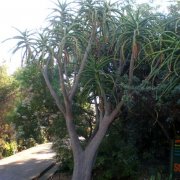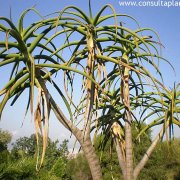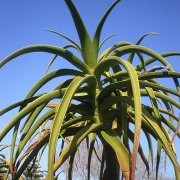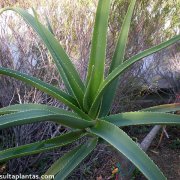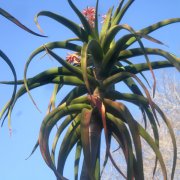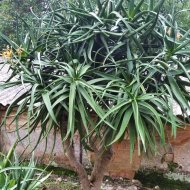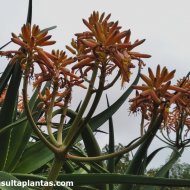Care of the succulent plant Aloe barberae or Tree aloe |
|
The genus Aloe is included in the subfamily Asphodeloideae (family Xanthorrhoeaceae), which comprises about 500 species of succulent plants native to Africa, Madagascar and the Middle East. Some species are: Aloe barberae, Aloe x caesia, Aloe pluridens, Aloe aristata, Aloe arborescens, Aloe aculeata, Aloe juvenna, Aloe variegata, Aloe striata, Aloe ciliaris, Aloe x delaetii, Aloe vera, Aloe ferox, Aloe x spinosissima, Aloe mitriformis, Aloe marlothii, Aloe maculata, Aloe plicatilis, Aloe thraskii, Aloe tenuior, Aloe suprafoliata, Aloe esculenta. Common name: Tree aloe. This species is native to South Africa and Mozambique. They are curious aloes of arboreal bearing with gray bark and rounded crown that reach 15 meters (49.21 feet) in height. The leaves (green with a dark and jagged margin) are curved, ribbed and appear in a rosette. They produce showy clusters of tubular pink or orange flowers. They bloom in winter. Tree aloe is used as isolated specimens in the garden, better on a slope or slope and away from buildings. They are suitable for Mediterranean gardens by the sea or as houseplants when young. Aloe barberae needs full sun exposure and a warm or temperate climate; does not tolerate frost. Tree aloe grows in any well-drained soil but prefer that it contains organic matter such as compost, humus, or leaf mulch. Water regularly, waiting for the soil to dry; space the waterings during the winter. Fertilize each fall with compost or earthworm humus. Wilted flowers and dried leaves should be pruned. Aloe barberae can be attacked by fungi if there is excess watering and by mealybugs and aphids. Tree aloe propagates from seeds sown in spring or by cuttings made in summer. |
Images of the succulent plant Aloe barberae or Tree aloe |
Find plants
Aloe barberae or Tree aloe | Care and Growing
© 2026 FavThemes
